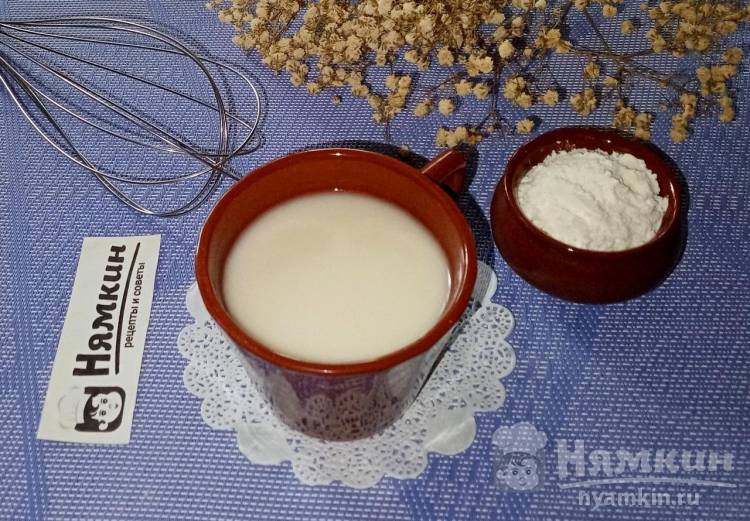4 способа избавиться от комочков в тесте и не допускать их в будущем
На чтение 3 мин. Просмотров 45.3k. Опубликовано 10.03.2020
Никто не любит комочки в любых их проявлениях. Будь то манная каша или тесто, каждая хозяйка стремится к гладкой консистенции. Сегодня мы поделимся с вами некоторыми лайфхаками, как избежать сгустков при приготовлении жидкого теста.
Просеять через сито
Муку всегда важно просеивать через сито. Но если случилась беда и в тесте для блинов остались комки, через сито или марлю можно пропустить и его. На сите останется та густая часть, которая и образовала ненужные комочки, а жидкая пойдет в миску.
Таким образом вы получите гладкую консистенцию и сможете приступить к выпеканию идеальных блинчиков.
Взбить миксером
Этот способ подойдет для более густого теста, к примеру, на оладьи или заливные пироги. Нужно на большой скорости взбивать миксером массу, пока все комочки не разобьются.
Но стоит помнить, что миксер не подойдет для подготовки воздушной, пышной выпечки, такой как бисквит, капкейки или панкейки.
Растереть вилкой
Бывает и такое, что миксер попросту отсутствует в доме или тесто требует бережного отношения. В этом случае на помощь придет обычная вилка. Процесс долгий и кропотливый, но проверенный временем и крайне прост.
Нужно каждый ненавистный комок растереть вилкой. Если у вас небольшое количество работы, то эту манипуляцию вы проведете без проблем. Комочки по одному постепенно разойдутся.
Поставить в холодильник
Пожалуй, самый простой способ исправить ситуацию и получить идеальную текстуру – использовать холодильник. Подойдет тем, у кого есть лишние 2 часа и нет желания долго возиться, борясь с комочками.
Нужно поставить тесто в холодильник на 2-3 часа, после чего достать и перемешать. В холоде сгустки разбухнут, а при механическом воздействии сами разрушатся. Так вы добьетесь нужной текстуры при минимальных трудозатратах.
Как не допустить образования комочков
Безусловно, лучше не бороться с последствиями, а предотвратить их. Чтобы не ломать голову над тем, как исправить ситуацию с неоднородной консистенцией, лучшим вариантом будет вовсе не допустить образования комочков. Для этого раскрываем секрет: сначала мука, потом жидкость.
К примеру, возьмем тесто для блинов. Нужно смешать яйца с небольшим количеством молока, просеять муку и только после вылить остальное молоко. Так вы совершенно точно избежите образования комочков.
С остальными видами теста дела обстоят еще проще – можно первым делом просеять муку, сделать в горке углубление и уже в него добавлять жидкие ингредиенты и замешивать тесто. Попробовав такой способ замеса, вы больше не будете делать это по-старому, поскольку так гораздо легче.
- Автор: Оксана Мухина
- Распечатать
Оцените статью:
- 5
- 4
- 3
- 2
- 1
(9 голосов, среднее: 3 из 5)
Поделитесь с друзьями!
Как быстро убрать комочки в тесте (и избежать их образования)

При приготовлении теста очень важно избегать появления комочков. Это помогает получить гладкую и приятную текстуру выпечки. Но что делать, если сгустки в тесте уже образовались? В статье мы поделимся советами опытных хозяек, которые помогут вам избавиться от комков.
Используйте сито или марлю
Обязательно пропускайте муку через сито перед добавлением в тесто. Это поможет вам избавиться от нежелательных примесей и частиц.
Если сгустки уже образовались, то пропустите тесто через сито. С этой целью вы можете также использовать марлю. Комки останутся на ткани или решетке, а жидкая часть пойдет в миску. Вы получите массу гладкой консистенции. Этот метод подходит для жидкого теста.
Взбейте тесто миксером
Такой способ подходит для теста более густой консистенции, которое используется для приготовления оладий или заливных пирогов.
Поместите тесто в чашу миксера и взбейте его на низкой скорости. Все комочки быстро разрушатся.
Этот метод нельзя применять, если вы готовите тесто для бисквитов, панкейков и капкейков.
Разотрите массу вилкой
Некоторые виды густого теста нельзя помещать в миксер, так как они требуют деликатного обращения. В этом случае воспользуйтесь вилкой. Вам предстоит долгая и кропотливая работа, но этот метод эффективен и проверен временем.
Разотрите каждый комок вилкой. Когда все сгустки будут разрушены, вы можете приступать к выпеканию.
Отправьте тесто в холодильник
Если у вас есть свободное время, то поставьте тесто в холодильник. Это самый легкий способ избавления от комочков.
Держите тесто в холодильнике 2-3 часа. Затем достаньте его и хорошо перемешайте ложкой или венчиком. В холоде комки разбухают. Впоследствии они легко разрушаются при перемешивании. Вы получите гладкую консистенцию при минимальных усилиях.
Как предотвратить появление комочков
Гораздо легче предотвратить образование комков, чем бороться с ними. Чтобы получить идеальную консистенцию теста, сначала насыпьте в миску просеянную муку, а затем добавляйте жидкие ингредиенты.
Сделайте в горке просеянной муки небольшую ямку. Вливайте в нее частями смесь из жидких продуктов. После каждого добавления хорошо перемешивайте массу. Старайтесь разбивать при замесе все сгустки и добиваться однородной консистенции. Такой метод приготовления поможет вам избежать появления комочков.
Заключение
Неоднородная консистенция теста негативно сказывается на текстуре и вкусе выпечки. Если у вас получилась масса с комками, то не приступайте к выпеканию до тех пор, пока полностью не разрушите все сгустки.
Нашли нарушение? Пожаловаться на содержание
1. Торт «Кружево»
Будем готовить: шокобисквит, вишню конфи, взбитый ганаш на молочном шоколаде, мусс на белом шоколаде, зеркальную глазурь.
2. Коронованная ежевика с инжиром
Будем готовить: сабле с фундуком, фундучный дакуаз, штройзель, хрустящий слой, компоте инжир-ежевика, фундучный мусс.
3. Торт «Солнечный лимон»
Будем готовить: штройзель, муале лимон, кремю лимон-имбирь, компоте лимон-груша, легкий лимонно-лаймовый мусс, декор меренга, зеркальная глазурь, мармелад лимонный на агаре.
4. Пирожное и торт «Горький шоколад»
Будем готовить: бисквит брауни, малина карамель, мусс с черным шоколадом, зеркальная глазурь.
5. Пирожное «Малиновое сердце»
Будем готовить: фисташка-крем, дакуаз с малиной, ягодное компоте, малиновая зеркальная глазурь.
6. Торт «Ягодный бум»
Будем готовить: японский бисквит, мусс на основе греческого йогурта, мусс из красных ягод, декор.
7. Макарон «Малина-чай матча»
Будем готовить: макарон, ганаш с чаем матча, малину кули.
8. Печенье дабл «Груша-тимьян»
9. Пирожное «Апельсин-капучино»
..Advertisements..
Continue reading below
How Do You Get Lumps of Cornstarch Out of a Sauce or Gravy? The easiest way to eliminate the unsightly appearance of starch granules lumping together in your sauce is to simply keep whisking until they break up.
How do you dissolve clumped cornstarch?
The best way to dissolve cornstarch in water without lumps is the following:
- Put cornstarch in a cup.
- Add cold water and not warm or hot water.
- Add double amount the water to cornstarch immediately, and mix until you get lump-free consistency.
- Add more water if needed.
How do you dissolve lumpy flour?
Dipping the spoon in to the middle of the sauce and bringing the back of the spoon the side. Do this for about 5 minutes and you should get most of the lumps, by using your eyes and catching as much as you can. I also add a little extra water, to help the lumps dissolve and continued to whisk and cook away.
Why does my corn flour go lumpy?
Cornflour starch is a large chain-like molecule that is tightly wrapped up in starch granules, so it doesn’t dissolve in water, as do salt or sugar. These large molecules tend to clump together as they are “hydrophobic”, which means they have a tendency to avoid water.
How do you get lumps out of corn flour gravy?
How to Fix Lumpy Gravy – CHOW Tip – YouTube
.Advertisements.
How do you get lumps out of flour sauce?
How to Fix Lumpy Gravy – YouTube
How do you fix lumpy batter?
One way to fix broken cake batter is to add a bit of flour, one tablespoon at a time, until it smooths out again. The flour helps the liquid and fat come back together and creates a smooth, lump-free mixture.
How do you get lumps out of dough?
It’s not a big deal, you can use it. Just add all the water for the next step of the process when you’re ready and mix it up really well, getting the lumps out, then add the rest of the flour and other ingredients.
How do you rescue lumpy white sauce?
How to Fix Lumpy Gravy – YouTube
Why is my flour lumpy?
What if there are lumps/clumps in my flour? Flour is hygroscopic and can come into contact with moisture during transit from the mill, in a warehouse or in storage. There may not be visible evidence on the outside of the bag, but it can form hardened particles, lumps or clumps of flour inside the bag.
SPONSORED LINKS
Continue reading below
Why is my cornstarch clumping?
Cook over medium heat or lower. Too-high heat can cause cornstarch to clump.
How do you dissolve flour?
Dissolve the flour in a saucepan by stirring it into in an equal amount of fat, such as melted butter, margarine or meat drippings, before adding in the milk. Dissolving flour before mixing it with milk prevents the starch in the flour from forming lumps.
What happens if you bake lumpy batter?
The good news is, while curdled batter is certainly a cake-baking problem, it can still be baked and produce a cake. … Beyond the uneven texture, cakes or cupcakes baked with curdled batter may also have less rise. When batter is properly emulsified, it can effectively trap air in the fat.
How do you get lumpy butter out of a cake mix?
Vigorously beat in a teaspoonful of alcohol-based vanilla extract, or a couple of teaspoons of milk until everything smooths out. Both help to emulsify the fat back into the batter.
Does granulated sugar melt while baking?
Aside from adding sweetness, granulated white sugar makes cookies browner (by caramelizing) and crisper (by absorbing moisture in the dough). It also encourages spreading as the sugar melts. The proportion of sugar in most cookie dough recipes is so high that only about half of the sugar dissolves during mixing.
How do you fix lumpy pasta?
You can always add more flour to a wet pasta dough, but once your dough becomes too dry, any attempt at rehydrating it usually ends in a gummy lumpy mess. Transfer the dough onto a clean surface. Leave the dried bits of dough and trace amounts of extra flour in the mixing bowl.
How do you break a lump in white sauce?
The cold water helps break the lumps and not stick to it and make them bigger. Another super cool hack is to switch off the flame, let the lumpy sauce (sans pasta) cool down a bit. Once it is cool, take out your blender, add the sauce in it. Add a bit more water and blend until smooth.
How do you get lumps out of flour and milk?
Pour in cold milk, a little at a time, continuously whisking until you get a smooth paste. The cold milk and constant stirring will separate the starch granules in the flour and prevent lumps from forming.
How do you get lumps out of mac and cheese?
How to fix lumpy cheese sauce
- As soon as you notice lumps forming in the cheese sauce you’re making, remove the pan from the heat. …
- Add a few drops of liquid. …
- If it doesn’t solve the problem, the next thing to do is add some flour, still keeping the pan off the heat. …
- Another trick is to add a little lemon juice.
How do you separate fine flour and lumpy flour?
The sieving flour is done to remove the coarse particle of flour from it so as to obtain fine flour for making chapattis. When wheat flour is put in a sieve and the sieve is moved back and forth repeatedly ,the fine particles of flour pass through the small holes of the sieve and collect in the vessel kept below.
How can I thicken flour without clumping?
When using flour as a thickening agent, be sure to thoroughly mix the water with the flour to prevent lumps. After stirring the combined flour and water into the sauce, cook and stir over medium heat until thickened and bubbly.
How do you fix too much corn flour?
Gently heat your sauce in a pot, stirring carefully and watch it thicken as it nears boiling temperature. You will most likely have enough starch left in the mix to reach the desired thickness. If not, add a bit of the reserved starch slurry, a teaspoon or so.
How do you get flour lumps out of a Roux?
If your bechamel sauce is turning lumpy while cooking, add ice-cold water instead of the next splash of milk and whisk like a banshee – it’ll magically sort out the lumps!
How do you fold flour without lumps?
How to “fold” in flour by Odlums – YouTube
How do you keep flour lumps out of cake batter?
But you can prevent those pesky lumps. Like with cake batters, lumps can form if you don’t sift the flour. If a recipe doesn’t call for sifting the flour, just give a few whisks (use a wire whisk) in the bowl. Flour settles when it’s stored so whisking aerates it.
Will butter lumps ruin my cake?
These little butter lumps will create holes in your cake because as the butter lumps melt, steam forms, and holes are left behind. If you are an occasional baker and store your flour in the freezer, be sure to let it come to room temperature before making your cake.
Can you eat cake with flour Lumps?
It’s possible you may have had a little pocket of flour in the batter which wasn’t throughly mixed in. How many have you got? If it’s just a few and you can pull them out, the cake is still perfectly edible.
How do you fix over beaten butter?
How to fix broken, grainy, or split buttercream – YouTube
What do I do if my butter won’t cream?
Your butter needs to be “room temperature”, or around 65ºF. If it is too cold, it won’t blend with the sugar evenly and will be almost impossible to beat it into a smooth consistency, if it is too hot, the butter won’t be able to hold the air pockets that you are trying to beat into it.
How do you get lumps out of cookie dough?
- Force the batter through a coarse sieve, a ricer, or a colander with appropriately sized holes.
- If any lumps remain (that weren’t pushed through), use the back of a spoon to force them through the strainer.
- If you have a significant number of lumps, you can also move them to another bowl, and squish it all into a paste.
What happens if you put less sugar in a cake?
Without enough sugar, your baked goods won’t rise properly. Creaming butter or eggs with sugar is an important step in many baked goods. It incorporates air into the batter or dough, helping them to puff up. Cutting back on sugar will reduce the amount of air going in!
What does salt do in baking?
The main function of salt in cake recipes is to enhance the flavor of the other ingredients. Its presence perks up the depth and complexity of other flavors as the ingredients meld. Salt also provides a balance to the sweetness of cake batters—but a salty flavor should not be discernible.
What happens if you put too much sugar in a cake?
Sugar interferes with the coagulation of proteins. Adding more sugar to a cake recipe causes the proteins in the flour and eggs to form weaker bonds, creating a more tender, softer crumb. … Excess sugar could weaken a cake structure so much that it collapses.
Why is my pasta lumpy?
Cooking pasta in a small pot means there won’t be enough cooking water. … That means the pasta will end up sitting in non-boiling water for a good amount of time, resulting in gummy, clumpy pasta. Sticky pasta can also result from the pasta starch to water ratio being too high.
Why is my pasta not smooth?
If pasta dough is too dry, adding a small amount of water at a time to the dough will solve the problem of having dried dough. If the pasta has not formed a perfectly moist ball after adding a little water, then you can add a small amount of flour to the dough to help obtain your desired texture.
What happens if you over knead pasta dough?
It’s almost impossible to over-knead a dough, though, since it’ll eventually build up so much elasticity that it won’t allow you to continue. That said, you don’t want to keep the dough out for too long, lest it begin to dry out.
…Advertisements…
CONTINUE READING BELOW
..Advertisements..
Continue reading below
How Do You Get Lumps of Cornstarch Out of a Sauce or Gravy? The easiest way to eliminate the unsightly appearance of starch granules lumping together in your sauce is to simply keep whisking until they break up.
How do you dissolve clumped cornstarch?
The best way to dissolve cornstarch in water without lumps is the following:
- Put cornstarch in a cup.
- Add cold water and not warm or hot water.
- Add double amount the water to cornstarch immediately, and mix until you get lump-free consistency.
- Add more water if needed.
How do you dissolve lumpy flour?
Dipping the spoon in to the middle of the sauce and bringing the back of the spoon the side. Do this for about 5 minutes and you should get most of the lumps, by using your eyes and catching as much as you can. I also add a little extra water, to help the lumps dissolve and continued to whisk and cook away.
Why does my corn flour go lumpy?
Cornflour starch is a large chain-like molecule that is tightly wrapped up in starch granules, so it doesn’t dissolve in water, as do salt or sugar. These large molecules tend to clump together as they are “hydrophobic”, which means they have a tendency to avoid water.
How do you get lumps out of corn flour gravy?
How to Fix Lumpy Gravy – CHOW Tip – YouTube
.Advertisements.
How do you get lumps out of flour sauce?
How to Fix Lumpy Gravy – YouTube
How do you fix lumpy batter?
One way to fix broken cake batter is to add a bit of flour, one tablespoon at a time, until it smooths out again. The flour helps the liquid and fat come back together and creates a smooth, lump-free mixture.
How do you get lumps out of dough?
It’s not a big deal, you can use it. Just add all the water for the next step of the process when you’re ready and mix it up really well, getting the lumps out, then add the rest of the flour and other ingredients.
How do you rescue lumpy white sauce?
How to Fix Lumpy Gravy – YouTube
Why is my flour lumpy?
What if there are lumps/clumps in my flour? Flour is hygroscopic and can come into contact with moisture during transit from the mill, in a warehouse or in storage. There may not be visible evidence on the outside of the bag, but it can form hardened particles, lumps or clumps of flour inside the bag.
SPONSORED LINKS
Continue reading below
Why is my cornstarch clumping?
Cook over medium heat or lower. Too-high heat can cause cornstarch to clump.
How do you dissolve flour?
Dissolve the flour in a saucepan by stirring it into in an equal amount of fat, such as melted butter, margarine or meat drippings, before adding in the milk. Dissolving flour before mixing it with milk prevents the starch in the flour from forming lumps.
What happens if you bake lumpy batter?
The good news is, while curdled batter is certainly a cake-baking problem, it can still be baked and produce a cake. … Beyond the uneven texture, cakes or cupcakes baked with curdled batter may also have less rise. When batter is properly emulsified, it can effectively trap air in the fat.
How do you get lumpy butter out of a cake mix?
Vigorously beat in a teaspoonful of alcohol-based vanilla extract, or a couple of teaspoons of milk until everything smooths out. Both help to emulsify the fat back into the batter.
Does granulated sugar melt while baking?
Aside from adding sweetness, granulated white sugar makes cookies browner (by caramelizing) and crisper (by absorbing moisture in the dough). It also encourages spreading as the sugar melts. The proportion of sugar in most cookie dough recipes is so high that only about half of the sugar dissolves during mixing.
How do you fix lumpy pasta?
You can always add more flour to a wet pasta dough, but once your dough becomes too dry, any attempt at rehydrating it usually ends in a gummy lumpy mess. Transfer the dough onto a clean surface. Leave the dried bits of dough and trace amounts of extra flour in the mixing bowl.
How do you break a lump in white sauce?
The cold water helps break the lumps and not stick to it and make them bigger. Another super cool hack is to switch off the flame, let the lumpy sauce (sans pasta) cool down a bit. Once it is cool, take out your blender, add the sauce in it. Add a bit more water and blend until smooth.
How do you get lumps out of flour and milk?
Pour in cold milk, a little at a time, continuously whisking until you get a smooth paste. The cold milk and constant stirring will separate the starch granules in the flour and prevent lumps from forming.
How do you get lumps out of mac and cheese?
How to fix lumpy cheese sauce
- As soon as you notice lumps forming in the cheese sauce you’re making, remove the pan from the heat. …
- Add a few drops of liquid. …
- If it doesn’t solve the problem, the next thing to do is add some flour, still keeping the pan off the heat. …
- Another trick is to add a little lemon juice.
How do you separate fine flour and lumpy flour?
The sieving flour is done to remove the coarse particle of flour from it so as to obtain fine flour for making chapattis. When wheat flour is put in a sieve and the sieve is moved back and forth repeatedly ,the fine particles of flour pass through the small holes of the sieve and collect in the vessel kept below.
How can I thicken flour without clumping?
When using flour as a thickening agent, be sure to thoroughly mix the water with the flour to prevent lumps. After stirring the combined flour and water into the sauce, cook and stir over medium heat until thickened and bubbly.
How do you fix too much corn flour?
Gently heat your sauce in a pot, stirring carefully and watch it thicken as it nears boiling temperature. You will most likely have enough starch left in the mix to reach the desired thickness. If not, add a bit of the reserved starch slurry, a teaspoon or so.
How do you get flour lumps out of a Roux?
If your bechamel sauce is turning lumpy while cooking, add ice-cold water instead of the next splash of milk and whisk like a banshee – it’ll magically sort out the lumps!
How do you fold flour without lumps?
How to “fold” in flour by Odlums – YouTube
How do you keep flour lumps out of cake batter?
But you can prevent those pesky lumps. Like with cake batters, lumps can form if you don’t sift the flour. If a recipe doesn’t call for sifting the flour, just give a few whisks (use a wire whisk) in the bowl. Flour settles when it’s stored so whisking aerates it.
Will butter lumps ruin my cake?
These little butter lumps will create holes in your cake because as the butter lumps melt, steam forms, and holes are left behind. If you are an occasional baker and store your flour in the freezer, be sure to let it come to room temperature before making your cake.
Can you eat cake with flour Lumps?
It’s possible you may have had a little pocket of flour in the batter which wasn’t throughly mixed in. How many have you got? If it’s just a few and you can pull them out, the cake is still perfectly edible.
How do you fix over beaten butter?
How to fix broken, grainy, or split buttercream – YouTube
What do I do if my butter won’t cream?
Your butter needs to be “room temperature”, or around 65ºF. If it is too cold, it won’t blend with the sugar evenly and will be almost impossible to beat it into a smooth consistency, if it is too hot, the butter won’t be able to hold the air pockets that you are trying to beat into it.
How do you get lumps out of cookie dough?
- Force the batter through a coarse sieve, a ricer, or a colander with appropriately sized holes.
- If any lumps remain (that weren’t pushed through), use the back of a spoon to force them through the strainer.
- If you have a significant number of lumps, you can also move them to another bowl, and squish it all into a paste.
What happens if you put less sugar in a cake?
Without enough sugar, your baked goods won’t rise properly. Creaming butter or eggs with sugar is an important step in many baked goods. It incorporates air into the batter or dough, helping them to puff up. Cutting back on sugar will reduce the amount of air going in!
What does salt do in baking?
The main function of salt in cake recipes is to enhance the flavor of the other ingredients. Its presence perks up the depth and complexity of other flavors as the ingredients meld. Salt also provides a balance to the sweetness of cake batters—but a salty flavor should not be discernible.
What happens if you put too much sugar in a cake?
Sugar interferes with the coagulation of proteins. Adding more sugar to a cake recipe causes the proteins in the flour and eggs to form weaker bonds, creating a more tender, softer crumb. … Excess sugar could weaken a cake structure so much that it collapses.
Why is my pasta lumpy?
Cooking pasta in a small pot means there won’t be enough cooking water. … That means the pasta will end up sitting in non-boiling water for a good amount of time, resulting in gummy, clumpy pasta. Sticky pasta can also result from the pasta starch to water ratio being too high.
Why is my pasta not smooth?
If pasta dough is too dry, adding a small amount of water at a time to the dough will solve the problem of having dried dough. If the pasta has not formed a perfectly moist ball after adding a little water, then you can add a small amount of flour to the dough to help obtain your desired texture.
What happens if you over knead pasta dough?
It’s almost impossible to over-knead a dough, though, since it’ll eventually build up so much elasticity that it won’t allow you to continue. That said, you don’t want to keep the dough out for too long, lest it begin to dry out.
…Advertisements…
CONTINUE READING BELOW
Как размешать муку без комочков в воде
(+0)
28 Января 2023 22:50
492
0
Мука – это популярный продукт на кухне, она входит в состав самых разных рецептов. И хотелось бы отметить, что не только выпечка готовится на ее основе. Довольно часто приходится размешивать муку в воде. Особенно это популярно для приготовления подлив и гуляшей. Многие хозяйки сталкивались с тем, что мука собиралась в липкие комки и плохо размешивалась. Поэтому я поделюсь с вами секретом, как правильно разводить муку в воде, чтобы не было комочков.
Мука
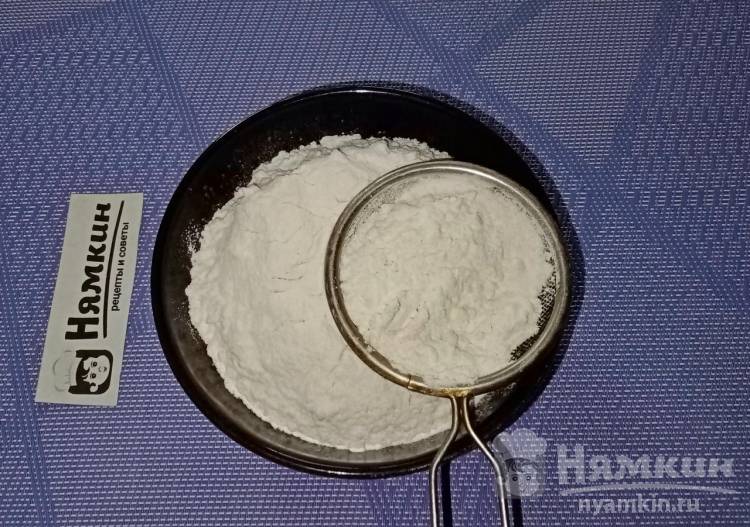
Важно подготовить пшеничную или любую другую муку. Понадобится сухое сито с мелкими ячейками. Муку необходимо просеять, чтобы избавиться от мелких частиц. Помимо этого продукт насыщается кислородом, что тоже очень важно в том, чтобы не образовывались комочки.
Соль
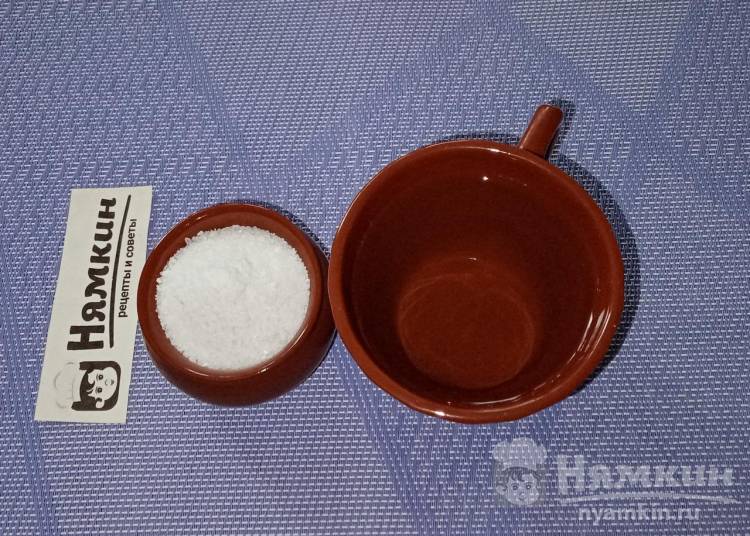
Есть мнение и проверенно на собственном опыте, что мука отлично размешивается в подсоленной воде. Рекомендуется использовать именно кипяченую воду комнатной температуры. В этой жидкости нужно сначала развести соль, а затем уже добавлять пшеничную муку.
На 200 мл кипяченой воды понадобится примерно 0,25 ч.л. соли.
Два способа размешивания
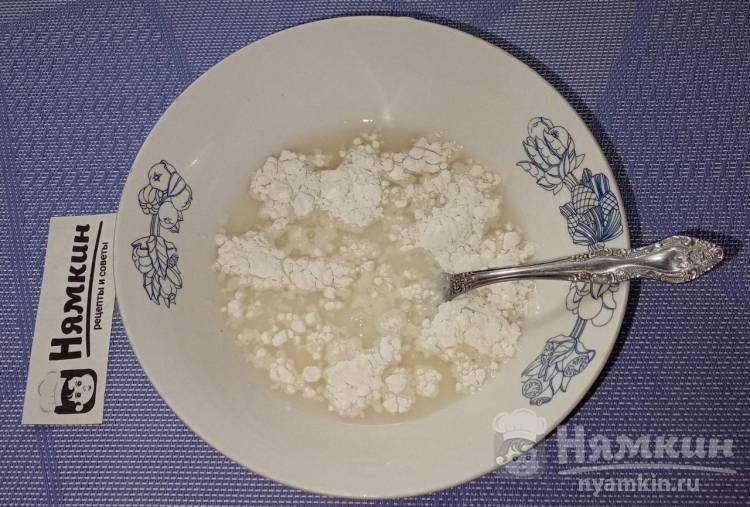
1-й способ: муку разводить в воде можно при помощи ручного венчика.
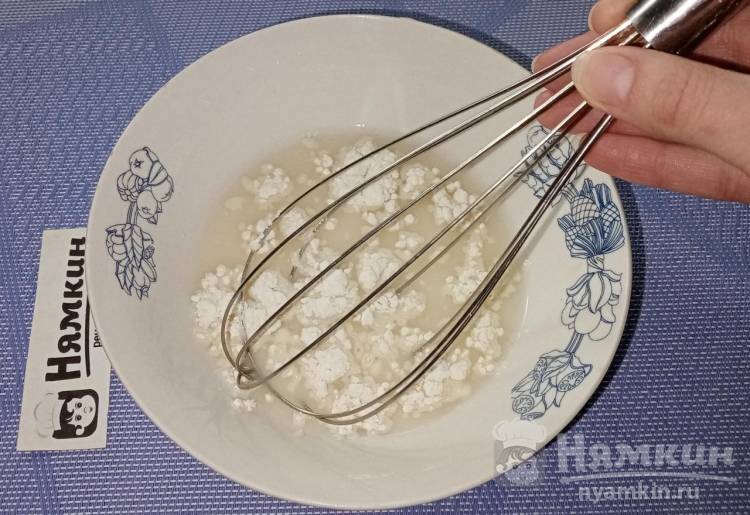
2-й способ: если муку добавлять в подсоленную воду, то комочки прекрасно разбиваются даже обычной ложкой.
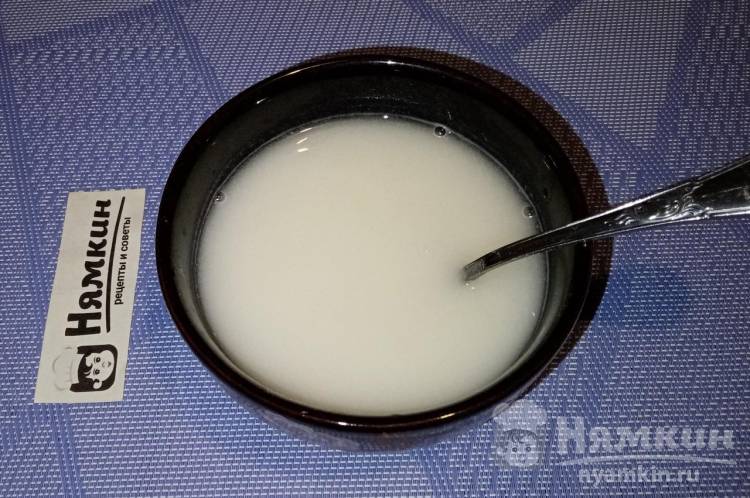
За считанные секунды, и даже не за минуты получается однородная белая масса. Мука разведена, и ее можно добавлять к остальным ингредиентам.
Подводя итоги, хотелось бы отметить, что мука хорошо разводится в подсоленной воде. А добавленная соль не ощущается в жидкости. Вообще по правилам в муку нужно добавлять воду, но бывают рецепты блюд, когда нужно именно сухой компонент добавить в жидкость.







